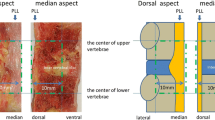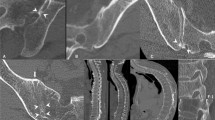Abstract
The purpose of this study was to investigate the relationship of ossification of posterior longitudinal ligament (OPLL) with enthesis, the site where the posterior longitudinal ligament (PLL) attaches to the vertebral body, by multi-detector CT reconstruction images. Twenty-nine patients with OPLL were studied. According to the plaques’ continuity to the vertebral body, OPLL plaques were classified into two categories: “free” and “contiguous”. A “broken sign” was defined as a crack between two plaques. The sites where each “contiguous” plaque attached to the vertebral body were then analysed. There were 78 ossified plaques in total, and six were “free”. There were eight cases with a “broken sign”, including six “free” ones. The site where all 72 “contiguous” plaques attached to the vertebral body included the zone where the PLL enthesis was situated, while other zones were included in only part of the plaques. Our conclusion was that there might be no real “free type” ossified plaques, and OPLL could start from enthesis, which indicated OPLL could be a kind of enthesopathy.




Similar content being viewed by others
References
Terayama K, Maruyama S, Miyashita R, Minai K, Kinoshita M, Shimizu Y (1964) Ossification of the posterior longitudinal ligament in the cervical spine. Orthop Surg 15:1083–1095 (in Japanese)
Sakou T, Matsunaga S, Koga H (2000) Recent progress in the study of pathogenesis of ossification of the posterior longitudinal ligament. J Orthop Sci 5:310–315
Schmidt MH, Quinones-Hinojosa A, Rosenberg WS (2002) Cervical myelopathy associated with degenerative spine disease and ossification of the posterior longitudinal ligament. Semin Neurol 22:143–148
Chen Y, Chen D, Wang X et al (2009) Anterior corpectomy and fusion for severe ossification of posterior longitudinal ligament in the cervical spine. Int Orthop 33:477–482
Cho JL, Park YS, Kim YH (1999) Tetraparesis associated with ossification of the posterior longitudinal ligament of the cervical spine. Int Orthop 23:247–248
Hori T, Kawaguchi Y, Kimura T (2006) How does the ossification area of the posterior longitudinal ligament progress after cervical laminoplasty? Spine 31:2807–2812
Hori T, Kawaguchi Y, Kimura T (2007) How does the ossification area of the posterior longitudinal ligament thicken following cervical laminoplasty? Spine 32:E551–556
Matsunaga S, Nakamura K, Seichi A, Yokoyama T, Toh S, Ichimura S, Satomi K, Endo K, Yamamoto K, Kato Y, Ito T, Tokuhashi Y, Uchida K, Baba H, Kawahara N, Tomita K, Matsuyama Y, Ishiguro N, Iwasaki M, Yoshikawa H, Yonenobu K, Kawakami M, Yoshida M, Inoue S, Tani T, Kaneko K, Taguchi T, Imakiire T, Komiya S (2008) Radiographic predictors for the development of myelopathy in patients with ossification of the posterior longitudinal ligament: A multicenter cohort study. Spine 33:2648–2650
Benjamin M, Toumi H, Ralphs JR, Bydder G, Best TM, Milz S (2006) Where tendons and ligaments meet bone: attachment sites ('entheses') in relation to exercise and/or mechanical load. J Anat 208:471–490
Benjamin M, McGonagle D (2001) The anatomical basis for disease localisation in seronegative spondyloarthropathy at entheses and related sites. J Anat 199:503–526
Loughenbury PR, Wadhwani S, Soames RW (2006) The posterior longitudinal ligament and peridural (epidural) membrane. Clinical Anat 19:487–492
Hashizume Y (1980) Pathological studies on the ossification of the posterior longitudinal ligament (OPLL). Acta Pathol Jpn 30:255–273
Mochizuki M, Aiba A, Hashimoto M, Fujiyoshi T, Yamazaki M (2009) Cervical myelopathy in patients with ossification of the posterior longitudinal ligament. J Neurosurg Spine 10:122–128
Sato R, Uchida K, Kobayashi S, Yayama T, Kokubo Y, Nakajima H, Takamura T, Bangirana A, Itoh H, Baba H (2007) Ossification of the posterior longitudinal ligament of the cervical spine: histopathological findings around the calcification and ossification front. J Neurosurg Spine 7:174–183
Yamamoto K, Kosaka T (2009) Updates of ossification of posterior longitudinal ligament. Effect of insulin/igf-1 signals and leptin signals on ossification of the spinal ligament in Zucker fatty rats. Clin Calcium 19:1462–1470 (in Japanese)
Tanno T (1992) Experimental study on the spinal lesions in hyperostotic mouse (twy/twy): special reference to the pathogenesis of the ossification of the spinal ligaments and to the action of ethane-1-hydroxy-1, 1-diphosphonate (EHDP). Nippon Seikeigeka Gakkai Zasshi 66:1073–1083 (in Japanese)
Takaishi H, Shiono Y, Matsumoto M (2009) Updates of ossification of posterior longitudinal ligament. Bone metabolism in ossifiction of posterior longitudinal ligament. Clin Calcium 19:1442–1447 (in Japanese)
Itoh H (1989) Histological study on the ossification of the yellow ligament in the thoracolumbar spines of the cadavers. Especially on the early stage of the ossification. Fukuoka Igaku Zasshi 80(12):527–535 (in Japanese)
Gaucher AA, Péré PG, Gillet PM (1990) From ankylosing spondylitis to Forestier's disease: ossifying enthesopathy, a unifying concept. J Rheumatol 17:854–856
Slobodin G, Rozenbaum M, Boulman N, Rosner I (2007) Varied presentations of enthesopathy. Semin Arthritis Rheum 37:119–126
Rogers J, Shepstone L, Dieppe P (1997) Bone formers: osteophyte and enthesophyte formation are positively associated. Ann Rheum Dis 56:85–90
Ball J (1983) The enthesopathy of ankylosing spondylitis. Br J Rheumatol 22:25–28
Hida K, Iwasaki Y, Koyanagi I, Abe H (1997) Bone window computed tomography for detection of dural defect associated with cervical ossified posterior longitudinal ligament. Neurol Med Chir 37:173–176
Chang H, Kong CG, Won HY, Kim JH, Park JB (2010) Inter- and intra-observer variability of a cervical opll classification using reconstructed CT images. Clin Orthop Surg 2:8–12
Disclosure
None of authors has a financial or personal relationship with another person or organization that could inappropriately influence (bias) her or his work. This work was prepared without sponsorship from any funding agency.
Author information
Authors and Affiliations
Corresponding author
Rights and permissions
About this article
Cite this article
Chen, J., Song, D., Wang, X. et al. Is ossification of posterior longitudinal ligament an enthesopathy?. International Orthopaedics (SICOT) 35, 1511–1516 (2011). https://doi.org/10.1007/s00264-010-1163-9
Received:
Revised:
Accepted:
Published:
Issue Date:
DOI: https://doi.org/10.1007/s00264-010-1163-9




